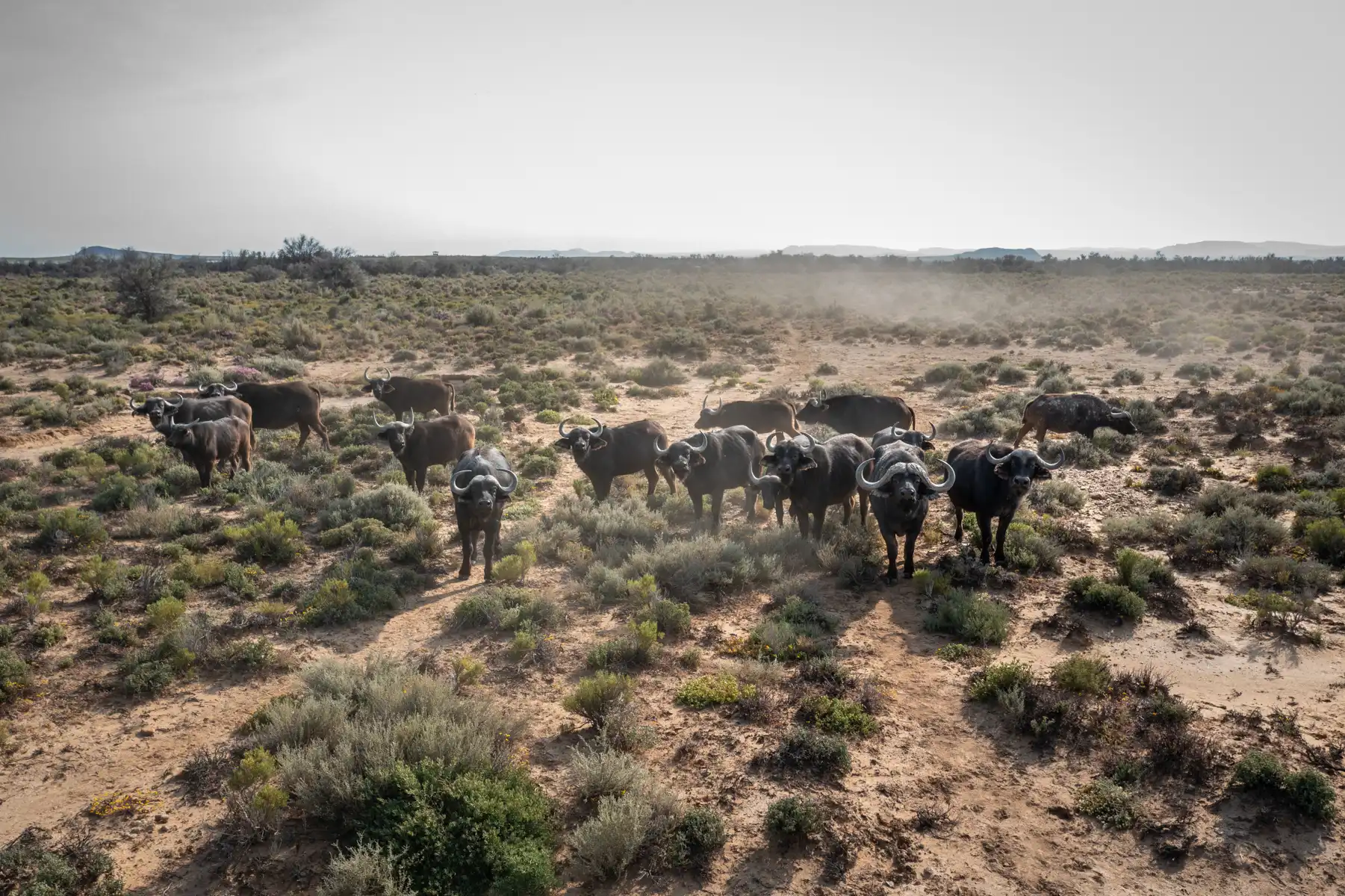
The Cape Buffalo
Buffalo / Big 5 Wildlife
Kingdom: Animalia
Phylum: Chordata
Class: Mammalia
Order: Artiodactyla
Family: Bovidae
Genus and Species: Syncerus caffer
Name
A prominent member of the Big 5, the Cape Buffalo, also known as the Southern Savanna Buffalo, is a distinct subspecies of the African Buffalo. While the exact origin of the name “Cape Buffalo” is unknown, it’s likely named after the southern African “Cape” region where it resides.
Appearance
Savanna Buffalos (Cape Buffalos) are large, heavy cow-like animals. They vary greatly not only in size but in the shapes of their horns and their colouring. Adults are usually dark grey or black (and can even appear tan or light brown if they have been wallowing in mud).
Females tend to have a more reddish hue compared to males. Male buffalo often grow darker as they get older. The oldest males, often living on the outskirts of the herds, can also be identified by silver hairs and dull or bald patches on their coats. Young buffalo are reddish-brown.
The Cape Buffalo’s most characteristic feature is their horns. Both males and females have heavy, ridged horns that can grow to impressive sizes. The horns are formidable weapons against predators and jostling for dominance within the herd. In males, the horns fuse at the base forming a thick bony plate called a “boss” on the forehead.

In male buffalo, the horns fuse at the base forming a thick bony plate called a "boss" on the forehead.
Size
Despite their relatively short stature, Cape buffalo are surprisingly massive.
Shoulder Height:
- Male: 1.5 – 1.7 meters (4.9 – 5.6 feet)
- Female: 1.3 – 1.5 meters (4.3 – 4.9 feet)
Body Length:
- Male: 3.4 meters (11.2 feet) on average
- Female: 1.7 – 3.1 meters (5.6 – 10.2 feet) on average
Weight:
- Male: 650 – 900 kilograms (1,433 – 1,984 pounds)
- Female: 425 – 700 kilograms (937 – 1,543 pounds)
Diet
Cape buffalo, like their bovine cousins, are grazing machines. Though they have a preference for tall, protein-packed grasses, these hardy and resourceful herbivores won’t turn down leaves, shrubs, or even swampy vegetation. However, maintaining their impressive size requires a significant dietary effort. Unlike nutrient-dense meals, grass offers less energy per bite. To compensate, Cape buffalo spend a large portion of their day grazing, constantly fuelling their massive bodies.
Location and Habitat
Buffalo aren’t picky about their environment, as long as there’s water nearby. These hardy and adaptable grazers thrive in sub-Saharan Africa, from the dry savannas to the lush wetlands. Whether it’s mountains, floodplains, or even woodlands, buffalos can handle it all. Cape buffalo are surprisingly tough and can survive in some pretty rugged environments.

Behaviour
Buffalo are highly social creatures, living in herds of up to a thousand animals. These herds are made up primarily of related females and their young, with a strict dominance hierarchy. Males tend to live on the fringes of the herd, only integrating during breeding season. Buffalo are grazers, and spend a large portion of their day searching for food and moving across the land from one grazing area to another.
Did you know that a buffalo’s sight and hearing are rather poor? but their scent is well developed in African buffaloes. They also seem to have a relatively difficult time regulating body temperature—the reason why they feed mostly at night. Although they are quiet for the most part, the animals do communicate. In mating seasons they grunt and emit hoarse bellows, and a calf in danger will bellow mournfully, bringing herd members running at a gallop to defend it.
They also exhibit interesting group behaviours. When threatened, they will form a protective circle around their young, and if a predator attacks, the herd will work together to chase it off. Buffalo are also known for their mud wallowing, which is thought to help cool them down and remove parasites.
Africa's Deadliest Big 5 Animal
The most fearsome member of Africa’s big 5 isn’t the lion, or even the elephant, but the buffalo. Known for its fiercely protective nature and incredible strength, Buffalos are considered one of the most dangerous animals to encounter in the wild — and for good reason!
Their unpredictable temperament, coupled with their massive size and sharp horns, has earned them a reputation for charging with surprising speed and ferocity. This aggressive behaviour is why big game hunters added the buffalo to the list of big 5 animals, referring to the five most dangerous animals in Africa to hunt, alongside the lion, leopard, elephant, and rhinoceros.
Cape Buffalo and the Red-Billed Buffalo Weaver
The Red-Billed Buffalo Weaver has earned its name through its unlikely friendship with the African buffalo. This mutually beneficial bond is all about nature’s answer to organic pest control! The Red-Billed Buffalo Weaver enjoys a tasty meal of ticks, fleas, and other bothersome insects. So, it’s a win-win — the buffalo gets relief from pests, and the weaver finds a plentiful food source. In fact, these feathered friends are so good at their job that you’ll often see them perched on not just buffaloes, but also elephants, giraffes, zebras, and other large herbivores in the wild.
Territory
Unlike some wildlife, Cape Buffalo don’t claim specific territories. Instead, these Southern African herds roam freely within reserves and protected areas. Their movements are guided by a more practical strategy — following the tastiest grazing grounds and reliable water sources.
Breeding
Females have their first calves around the age of four or five years old. They usually calve only every two years, and can breed year-round. However, most births occur at the end of the rainy season (September through December) when abundant grass improves the nutritional level for females when they are pregnant or nursing.
The gestation of Cape Buffalo is approximately 11 months, with a single calf born. Like most herbivores, calves are able to walk shortly after they’re born. Female buffalo ‘cows’ and their offspring have a strong and prolonged relationship, which often continues into maturity within the social structure of the herd. Beyond breeding with the females and providing protection for the herd, male ‘bulls’ do not invest in their calves.
Calves are suckled for up to a year and, during this time, are completely dependant on their mothers for protection and nutrition. Female offspring usually stay in the natal herd, but young males often leave when they reach sexual maturity, usually when they’re about three to four years old.
Challenges and Threats
Outside national parks, African buffalo are considered are seen as dangerous animals posing a threat to local communities and farms. In parts of Africa, they are known to break fences, raid cultivated crops, and can even carry bovine diseases which are transmissible to livestock.
However, the biggest threat to buffalo populations is human activity. As large grazing animals, buffalo need vast areas of land and vegetation to thrive. Their need for vast grazing lands conflicts with agriculture, urban development, and habitat fragmentation. Wildlife poaching and snares further jeopardises their long-term survival in the wild.
Facts about the Cape Buffalo
According to the IUCN Red List, Cape Buffalo are classified as Near Threatened, with a decreasing population of about 400,000 animals left in the wild.
Cape Buffalo are known to be vocal animals, and like cows, they can make a variety of sounds and calls.
- Mumbling: This is a common sound for communication within the herd. It can be short or long grunts.
- Gargling: This sound is particularly important between mothers and calves, but also among females who help raise young together. It can also be a warning of danger or a way to locate a lost calf.
- Grunting: Loud, short grunts are used to express dominance or intimidation. Herds will use this sound to scare off approaching predators like lions.
Yes, the African Buffalo (including the Southern Savanna Buffalo and Cape Buffalo) is a member of Africa’s Big 5 animals, alongside the lion, leopard, elephant and rhino.
Despite being herbivores, Cape Buffalo are surprisingly dangerous. Their unpredictable temperament and fiercely protective nature mean they may charge with surprising speed and ferocity, especially when they feel their young or herd is threatened. Their massive size, sharp horns, and poor eyesight all contribute to the danger they pose.
Cape Buffalo can reach speeds of up to 50 kilometres per hour (31 miles per hour).
Cape buffalo are active feeders. Though they spend most of the day grazing, their peak activity periods occur in the cooler temperatures of the early morning and late afternoon. This strategic grazing schedule allows them to maximise their food intake while avoiding the scorching midday sun.
Baby or young buffalo are called calves (singular: calf).

